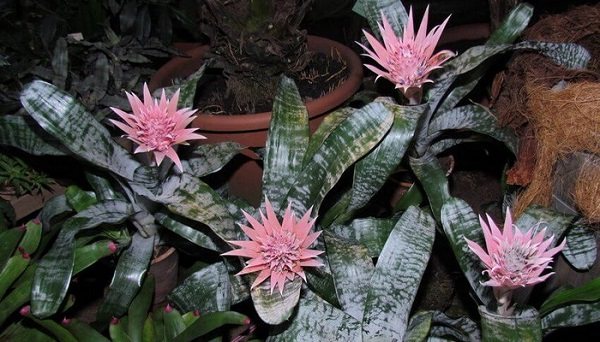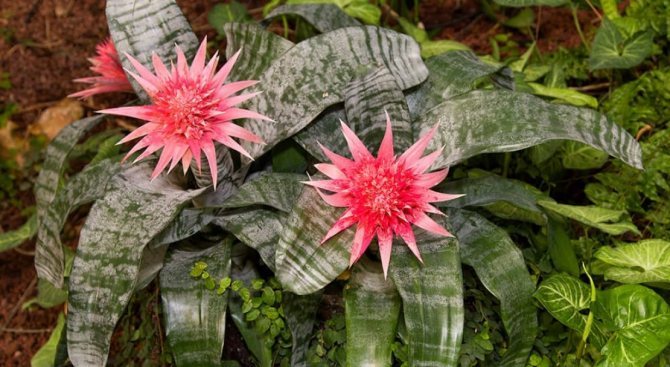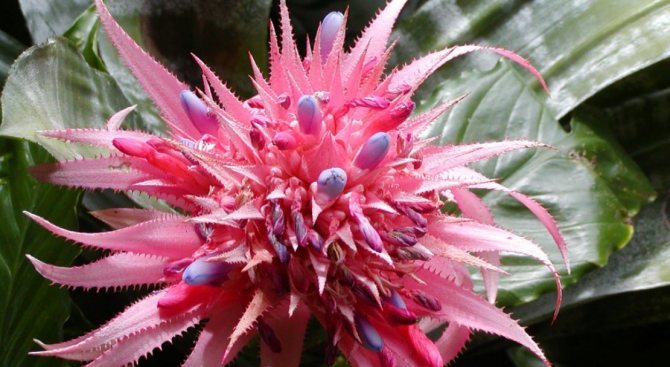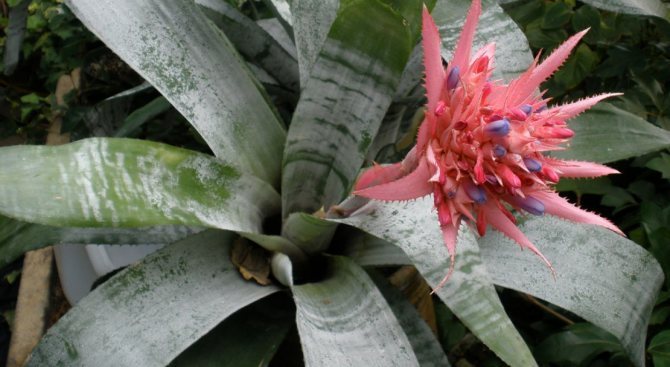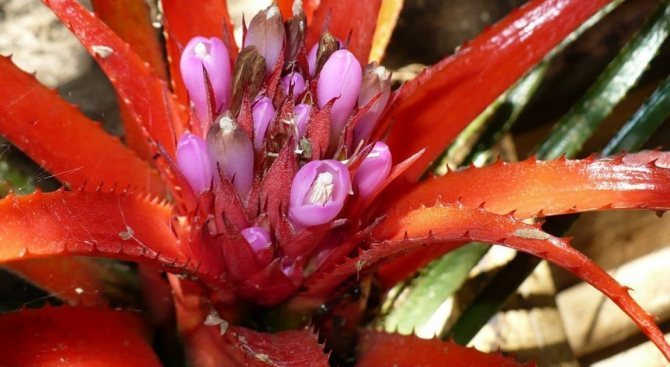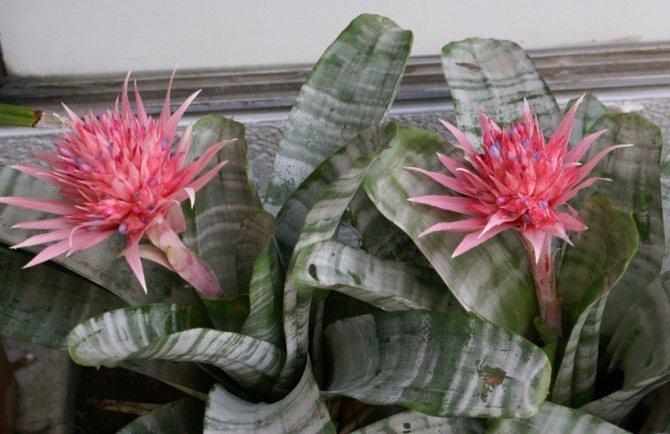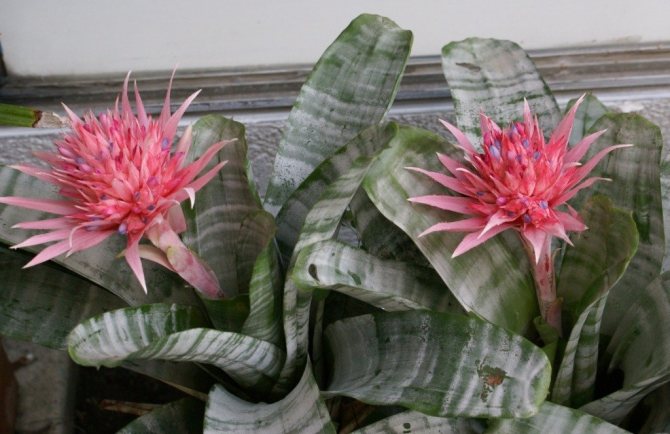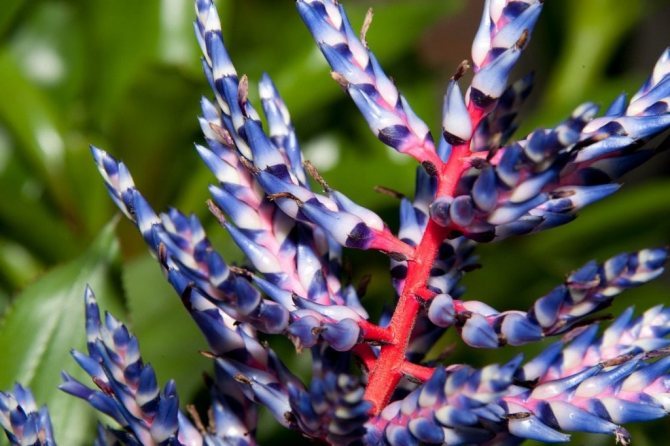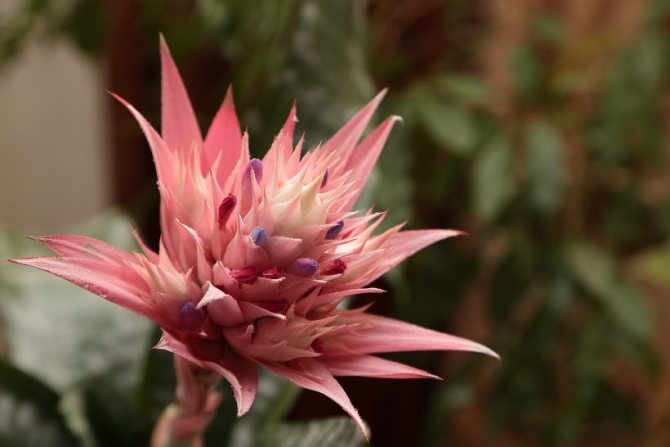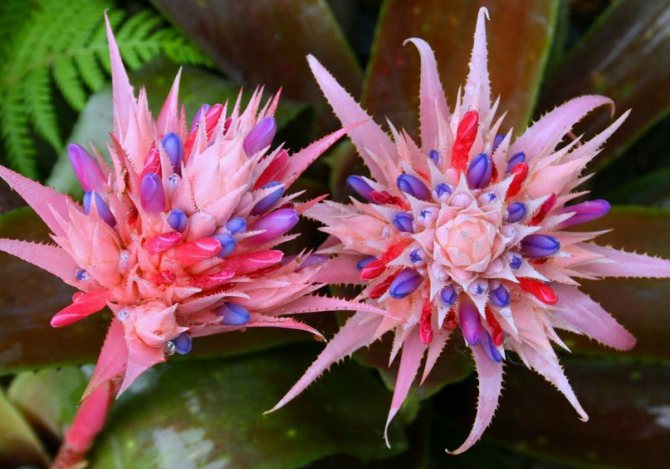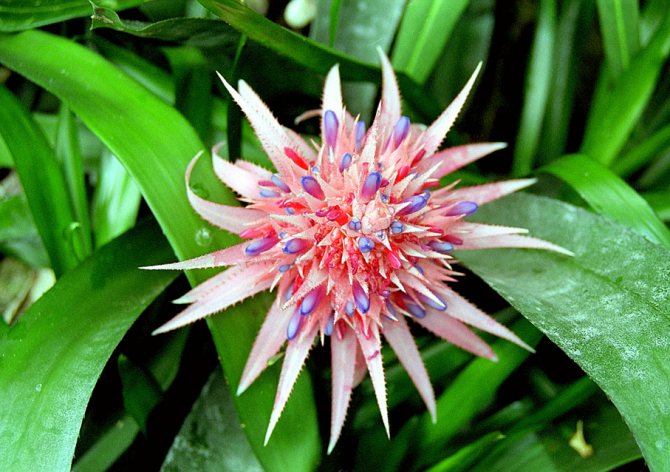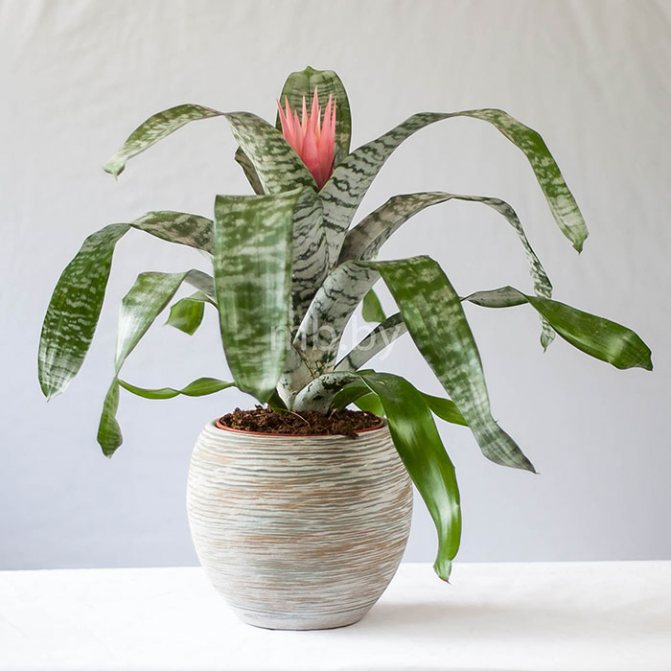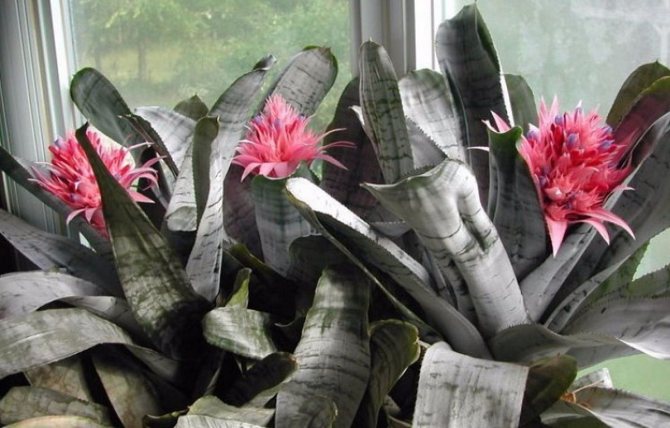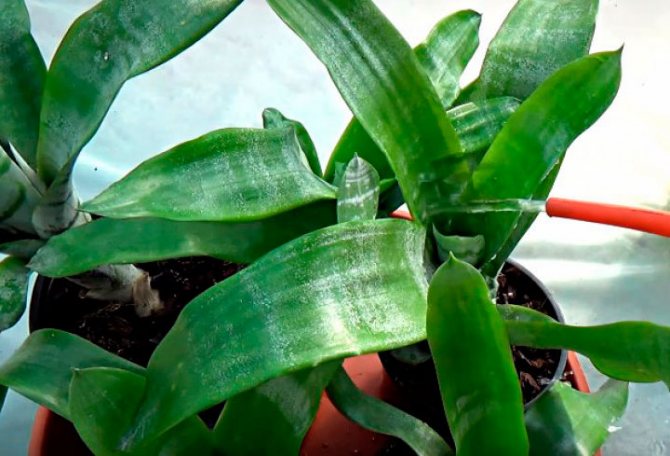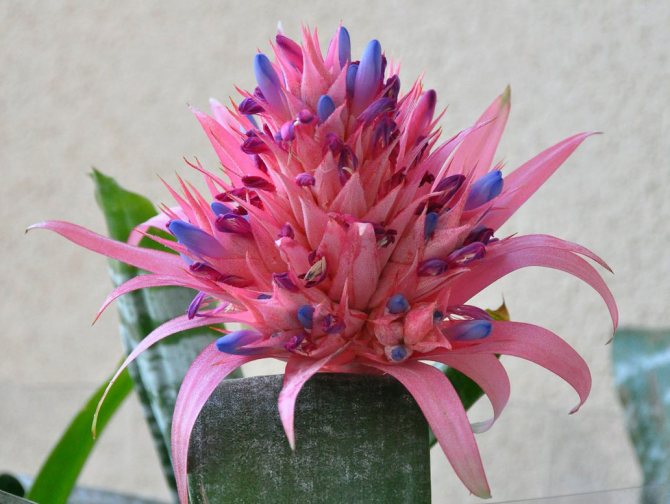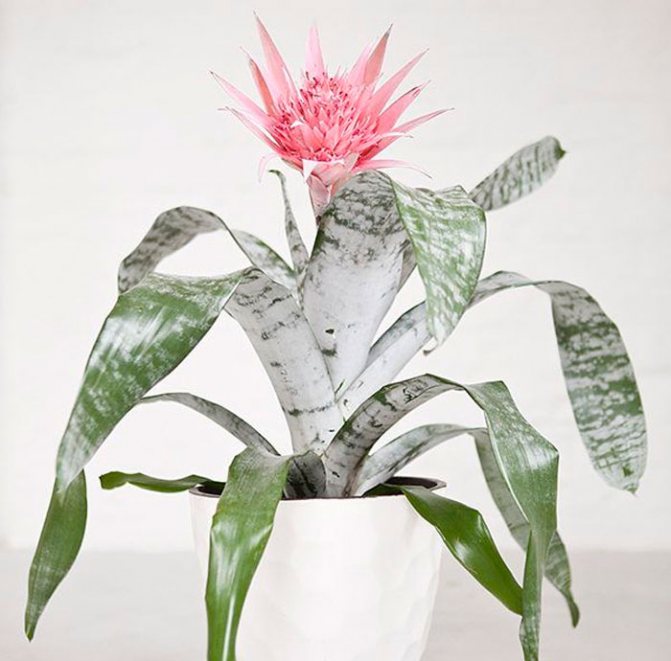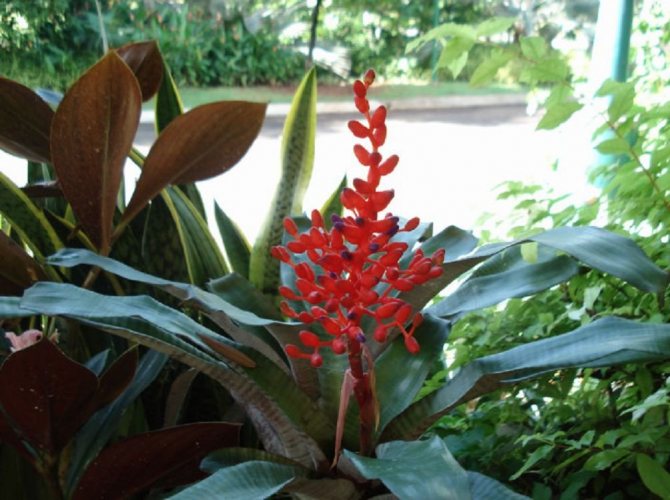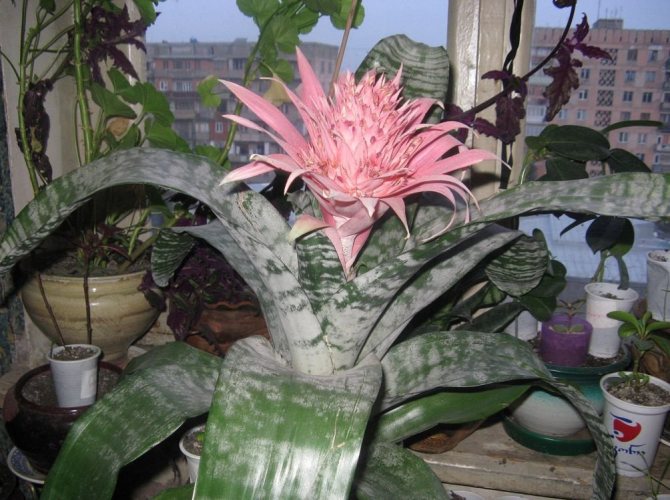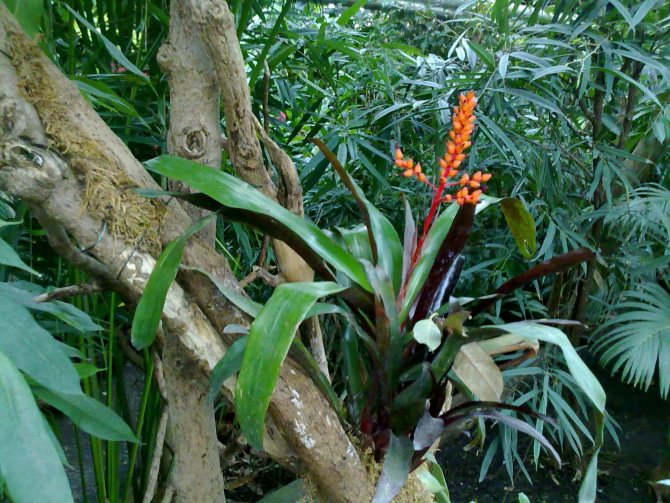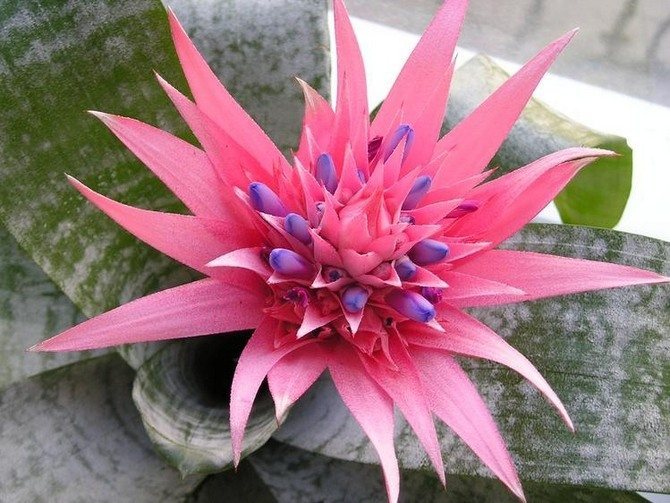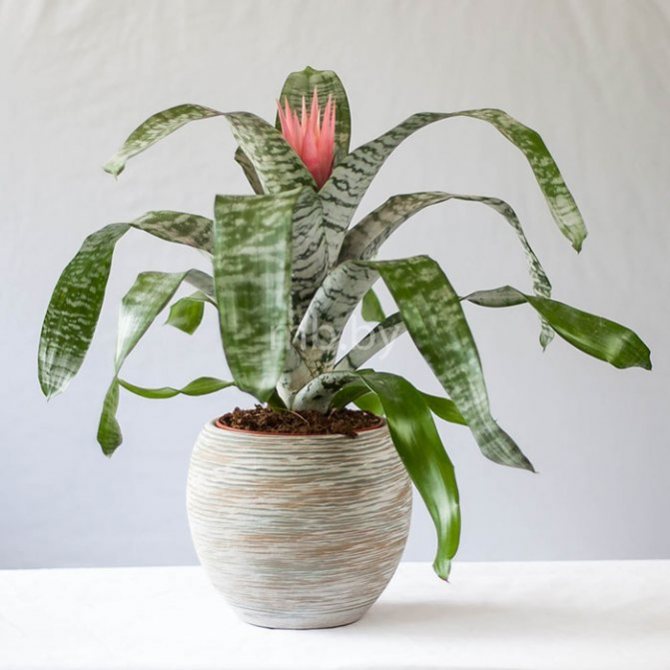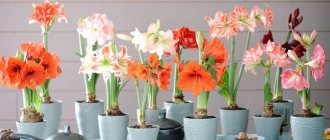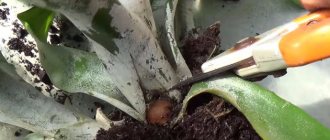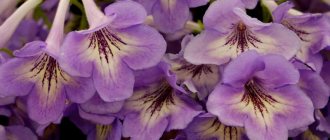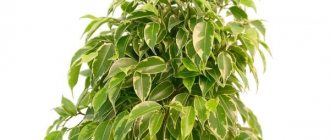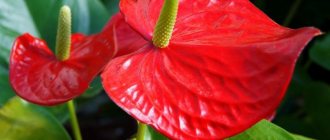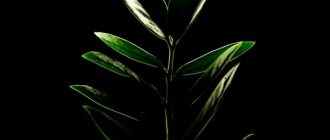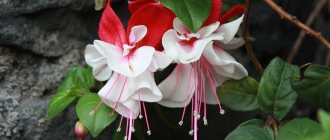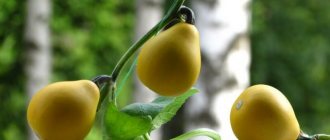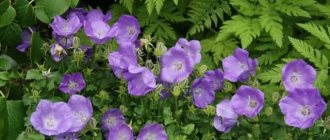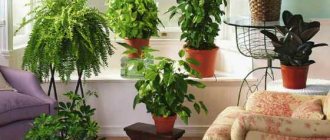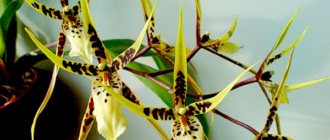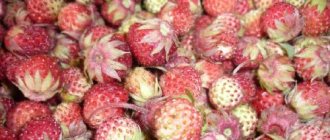The origin and appearance of the plant
Homeland - tropical forests of Central and South America. Ehmeya is a representative of the bromeliad family (like pineapple, gusmania, etc.).
In nature, it prefers illuminated places in dry climates. At home, it feels great, unpretentious in care. The decorative role is played not only by flowers, but also by original leaves.

Blooming ehmeya is a very beautiful sight
Belt-like pointed leathery leaves with spines along the edges are collected in a rosette and, as a rule, are painted in a variegated, grayish-green or monochromatic dark green hue. The stems are short. When flowering from the middle of the rosette, a thick pink peduncle appears, which is much smaller in size than the bracts. After flowering, the rosette dies off.
Echmea leaves have thorns, its juice is poisonous. In contact with the skin, it causes inflammation. Access to the plant for children and animals should be limited.
In nature, there are more than 170 species of ehmea, 10 of them are grown at home. The most popular among florists are the following types:
- Sparkling. The leaves are rounded at the end, their upper part is green, the lower one is reddish. The flowers are small, red.
- Striped (example fasciata). The tubular rosette is assembled from belt-like leaves. Compound inflorescence about 30 cm. Bracts are pink. The offspring appear on creeping stems.
- Curved. Inflorescence is about 20 cm long, red in color. Blooms in April-May.
- Shaggy. The rosette is formed by densely collected leaves. The flowers are yellow and the bracts are red. Blooms in winter.
- Bearded (tailed). The flowers are golden, the bracts are red. The peduncle is covered with a white coating.
- Weilbach. Leaves up to 0.5 m in length. Blooms from March to August, sometimes in October.
Photo gallery: example fasciata, striped, curved and other types of echmea
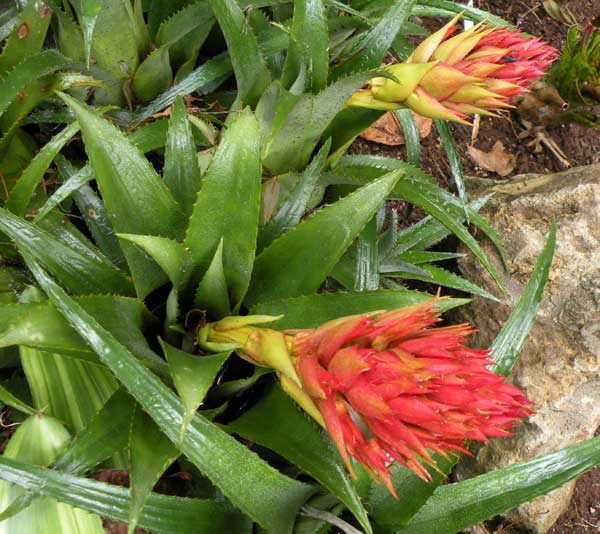

Echmea inflorescence curved - 20 cm in length
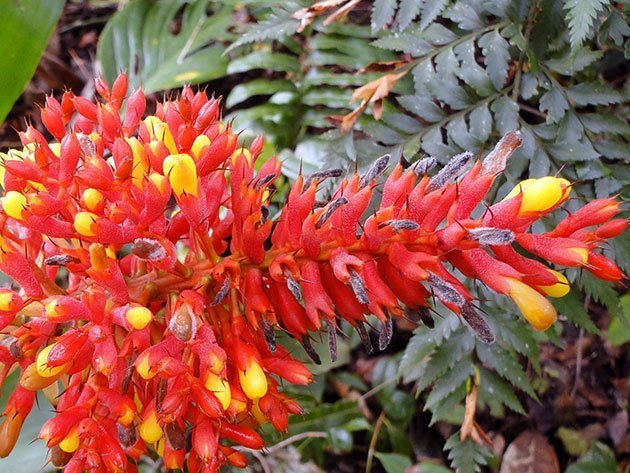

The bearded echmea has golden flowers
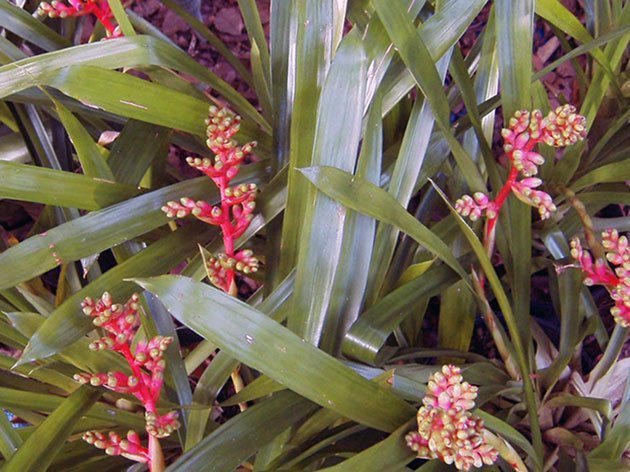

Ehmeya Weilbach can please with flowering and autumn
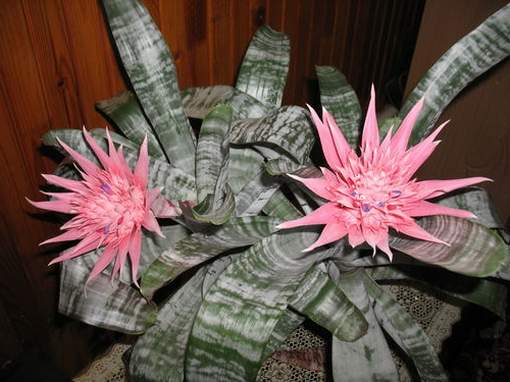

Ehmeya striped - one of the most popular plant species


Ehmeya shaggy blooms in winter
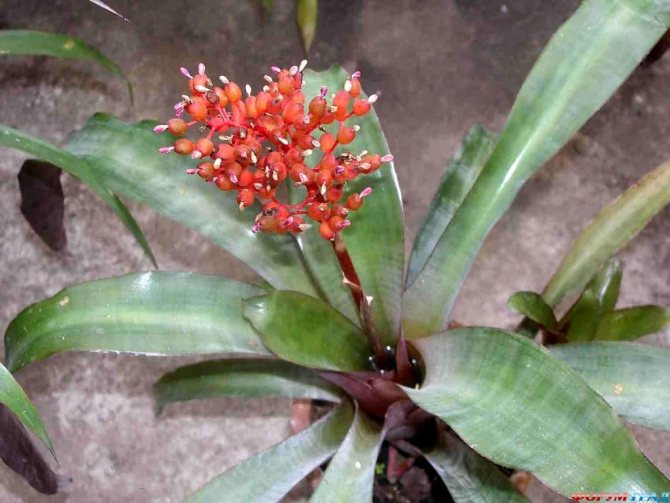

The upper part of the leaves of sparkling echmea is green, the lower part is purple-red
Ehmei features
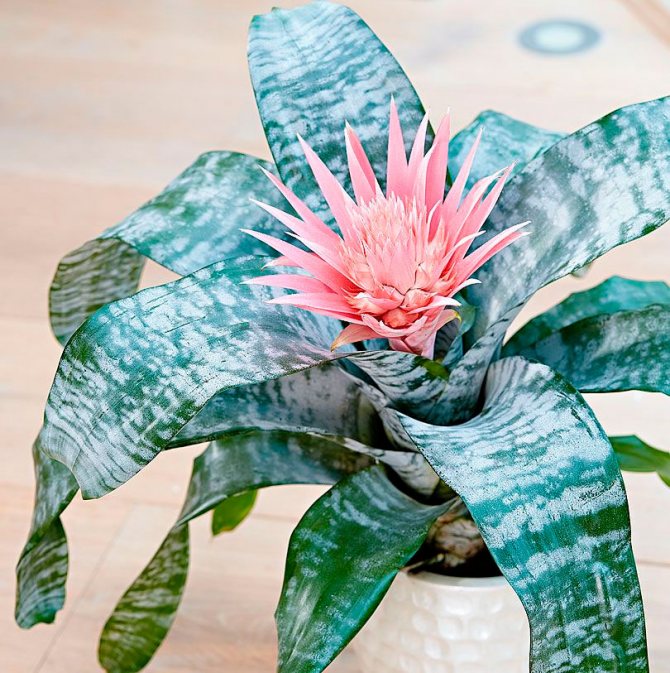

Among the numerous species of the genus Echmeya, both terrestrial and epiphytic plants are found. This plant differs from other representatives of the bromeliad family in that thorns are located on the edge of the foliage. The leaves form a rosette, while their color can be variegated or monochromatic, and they can also be soft leathery or dense hard. The fruit is a berry.
Ehmeya is quite popular with flower growers, even though each rosette of leaves can bloom only once. This plant also differs from other bromeliads in that it is quite simple to grow it indoors.
Conditions for ehmei depending on the season
| Season | Lighting | Humidity | Temperature |
| Spring Summer | South-east or south-west windows. The south windows are shaded from the direct rays of the sun. | Some types of echmea tolerate dry air well, while others require moderate humidity. The plant should not be in a draft, but the room should be regularly ventilated. | 20-27 ° C |
| Autumn winter | Spray the leaves regularly or place the pot on a tray filled with water and fine gravel. | not lower than 16-18 ° С |
Lighting and temperature
Ehmeya loves bright light. This is one of the few indoor plants that tolerates direct sunlight well. Its tough, leathery leaves do not suffer from sunburn, even in the summer heat. You can grow the plant in diffused lighting. But with a lack of light, it will grow poorly and will refuse to bloom.
In the spring-summer period, the temperature for keeping echmea should be between 20-26 ° C. Moreover, at night the temperature should be at least 20 ° C, during the day - 25-26 ° C. The difference between day and night temperatures of 5-6 ° C stimulates flowering. This plant is very thermophilic, so sudden changes in temperature during the daytime can harm it.
In winter, a dormant period must be created for the plant.... At this time, the temperature is reduced to 15-17 ° C.
At rest, the flower does not grow, therefore, watering is sharply reduced, making sure that the soil in the pot remains only slightly damp.
It is undesirable for the air in the room where the ehmeya grows to stagnate. At high humidity, putrefactive fungi and bacteria multiply very quickly. Therefore, in summer, and especially in winter, you need to regularly ventilate the room. But the plant should not stand in a draft, it is located away from the opening sashes of the window.
How to plant and transplant at home
Echmeya must be transplanted once a year - in the spring, after flowering. Faded rosettes are removed. For ehmeya, you need a shallow wide pot, on the bottom of which drainage should be put (broken shards, expanded clay).
Drainage at the bottom of the pot is essential for ehmea
Soil: turf and leafy land (2 parts each), sand and humus (1 part each), plus a little moss and charcoal. Soil for bromeliads is also suitable.
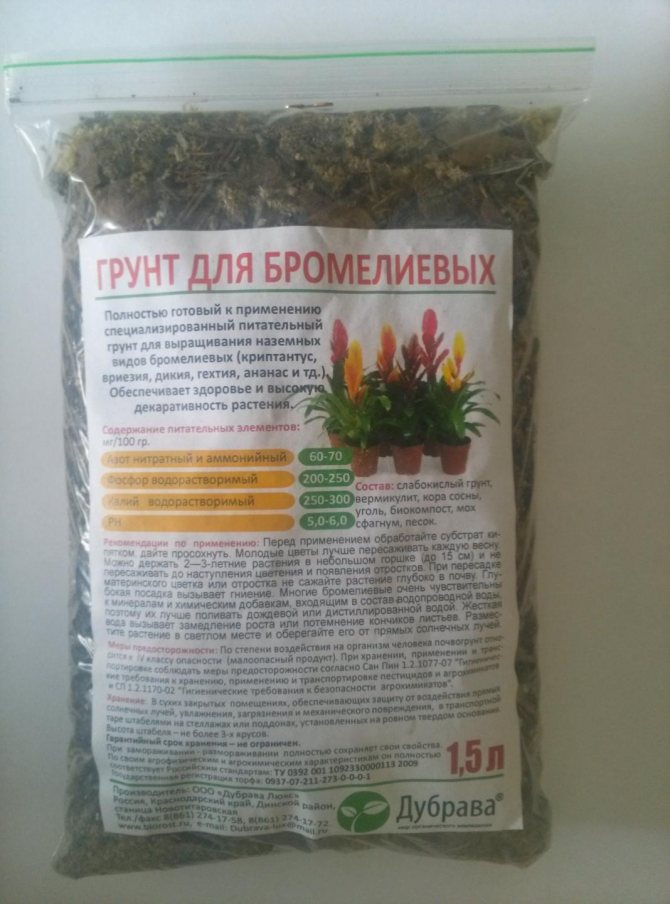

Soil for bromeliads is also suitable for echmea
The procedure for transplanting echmea is as follows:
- Carefully remove the plant from the pot, shake off the soil from the roots a little. It is not necessary to remove it completely.
- Place in a pot and sprinkle with substrate.


After transplanting, ehmey does not need to be watered for 2-3 days - Do not water and keep in a shaded place for 2-3 days.
Reproduction methods
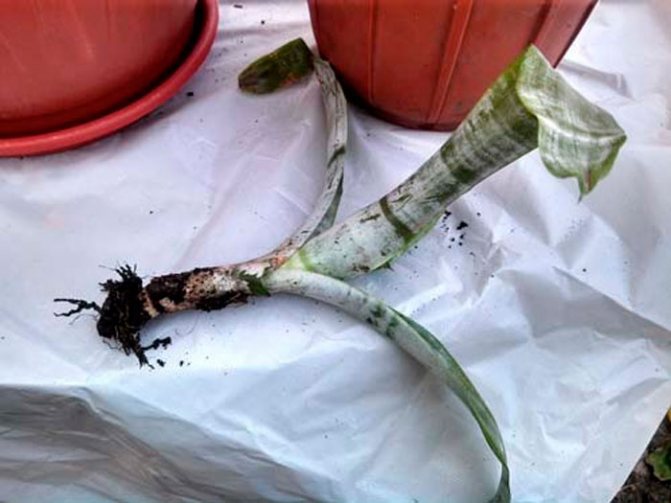

How to propagate by offspring
For reproduction of room echmea, the vegetative method is most often used. To do this, in the first spring weeks, offspring are separated from the adult bush, which should be more or less developed. They will root quickly enough after planting in a separate pot. Places of cuts on the parent bush and on the offspring are treated with coal powder, otherwise rot may appear on the flower. For planting offspring, small individual pots are used, which are filled with one of the soil mixtures listed above.
Growing from seeds
If desired, such a flower can be grown from seeds. However, this method has several disadvantages, namely, it is more complex and time-consuming, and seedlings grown from seeds may not retain varietal characteristics.
For sowing seeds, the selected container is filled with chopped fern roots, peat or finely chopped sphagnum. Crop maintenance is pretty simple. They need to be placed in a warm (from 22 to 24 degrees) and shaded place, in addition to this, they are provided with systematic watering and ventilation. 3 months after sowing, the seedlings should be cut into a substrate consisting of leafy and heather soil. And when another 12 months have passed, the grown seedlings can be transplanted into the substrate that is used for planting adult specimens (see above). During a given year, the plants should be watered moderately, the foliage should be moistened with a sprayer, and they should be kept warm (20 to 26 degrees).
Care
Watering
Ehmeya watering is carried out in two stages: first pour water into the outlet, then spill the soil.
Water for irrigation needs settled and warm.
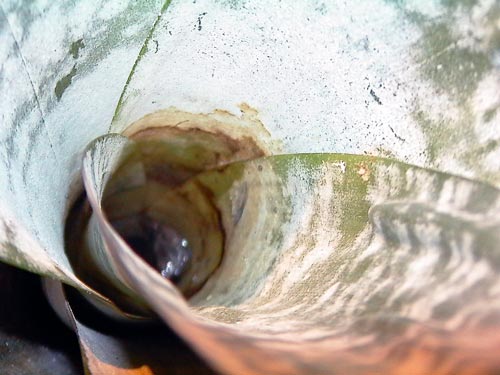

Water in the outlet should only be in the warm season.
Ehmeya approves of wet, but not too wet soil.Water it when the topsoil is dry. In the warm season, there should be water in the funnel. It should be changed every 2-3 days, removing the old napkin. After flowering, as well as in the cold season, the outlet must be dry, otherwise rotting will begin. Watering the land in winter is also reduced to 1-2 times a month
Top dressing
Top dressing is carried out in the summer once every 20 days, in the fall - once a month, in the winter - once every 1.5 months. Use complex mineral fertilizers in liquid form, fertilizers for epiphytes (bromeliads or orchids) or conventional fertilizers for flowering plants (in this case, the concentration should be taken half as much as indicated in the instructions). The mixture should not fall into the outlet of the plant.
Fertilizer for bromeliads is suitable for feeding echmei
Blooming - how to make ehmeya bloom
Echmea bloom covers the period from April to August. Some varieties bloom in winter (for example, shaggy ehmeya). Under natural conditions, the plant is ready to bloom at 4–5 years of age. This process can also be triggered artificially. Methods:
- Put apples and oranges next to the pot, cover everything with foil. The gas emitted by the fruit accelerates the onset of flowering.
- Place a piece of calcium carbide in the funnel. It interacts with the water in the funnel, resulting in the release of the same gas - ethylene.
- Sometimes flowering causes a large difference in daily temperature.
Florists do not recommend resorting to stimulating the flowering process. As a rule, after this, the plant dies off, because the young ehmeya spends a lot of energy on it.
After flowering, the rosettes with peduncles should be unscrewed or cut out.
Dormant period
The rest period in ehmey is poorly expressed. However, in winter, it is necessary to provide the plant with a low temperature (16 ° C), reduce watering and feeding.
3. Varieties:
3.1.Echmea striped or fasciata - Aechmea fasciata
Perennial plants forming a rosette of belt-like, glossy, green leaves. The plant blooms only once, then the main rosette dies off, leaving small daughter plants near it. The leaves reach a length of 60 cm and often have transverse silvery stripes on the surface. At the age of 3-4 years, a short, thick peduncle up to 15 cm high is formed in the center of the rosette. At the top of the peduncle, an inflorescence appears, consisting of bright, pink bracts and small lilac or bluish flowers. Flowers fade quickly, but pink bracts adorn plants up to 6 months. The green mass of plants of this species is poisonous, so the flower should be placed out of the reach of children and pets, and in contact with bushes, use protective gloves and wash hands thoroughly with soap.
↑ Upward,
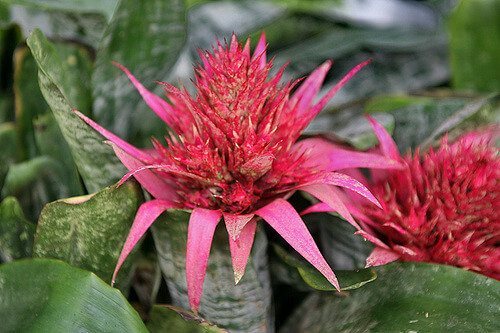

3.2 Echmea sparkling - Aechmea fulgens
Evergreen herbaceous plants with wide, green, belt-like leaves reaching a length of 30 cm. The leaves are collected in rounded basal leaf rosettes. During the flowering period, a vertical, short, strong, red peduncle with a large, branched inflorescence at the top appears in the center of the rosette. The inflorescence bears many bright scarlet or pink bracts and purple flowers. There are attractive variegated varieties with longitudinal pink or white stripes on the leaves. In some plants, the lower surface of the leaves is painted in a contrasting burgundy or even purple hue. It blooms only once.
↑ Upward,
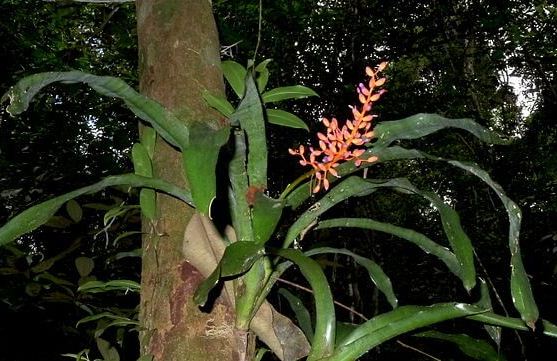

3.3 Aechmea Blue Rain
A large evergreen plant with dark green, long, belt-like leaves, collected in a basal leaf rosette. During the flowering period, the plants form a tall red peduncle, which bears at the top a large branched inflorescence with bright bluish-white bracts and purple flowers.
↑ Upward,
Table: why leaves turn yellow, dry, brighten - care errors and ways to eliminate them
| What's going on | Cause | Solutions to the problem |
| Does not bloom | care conditions are not met |
|
| the plant has not reached 4 years of age | Wait or stimulate flowering. | |
| Rotting of the socket is observed | excess watering |
|
| Root rot detected | excess moisture, heavy soil | Transplant the plant by cutting off the damaged roots. |
| Leaves brighten | excess sunlight | Move the pot to another place or shade the plant. |
| Brown spots appear on the leaves | sunburn | |
| Leaf tips dry | lack of moisture, dry air |
|
| Leaves turn yellow | the plant is affected by disease or pests | see below |
Fertilizing and watering ehmeya
For irrigation, use soft, settled water, always warm. In spring and summer, regular and abundant watering is needed, first in the funnel, then in the ground. The water in the outlet must be changed every 2 weeks to avoid stagnation. You can drain the excess liquid by tilting the plant, holding it firmly, or removing it with a napkin.
Water less often in the autumn-winter period. At temperatures below +20 ° C, it is important to keep the outlet dry.
Feed with fertilizer for bromeliads from March to October, every two weeks, combining foliar method with watering. Spray with the solution or pour it into the funnel.


Disease and pest control - table
| Pests / Diseases | How does it manifest | Control measures |
| Spider mite | Small arthropods entangling leaves with cobwebs. Affected leaves turn yellow, fall off, the plant loses strength. |
|
| Shields | Small insects that look like dark plaques leaving sticky marks. When damaged by scale insects, Echmeya lags behind in growth, the leaves turn yellow and dry out. |
|
| Mealybug | Small insects that damage the ground part of plants. The colonies look like cotton wool. Ehmeya, affected by the worm, stops development. | |
| Root worm | Forms oviposition at the root collar, which leads to root rot. |
With a strong defeat, the plant is almost impossible to save. |
| Root rot | May develop due to waterlogged land. Leaves turn yellow, darken, wither and fall off. |
If the roots have darkened and softened, then the plant cannot be saved. |
Photo gallery: echmea diseases and pests
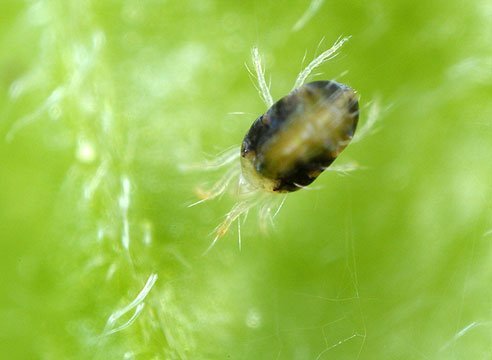

Spider mites entangle plant leaves with cobwebs
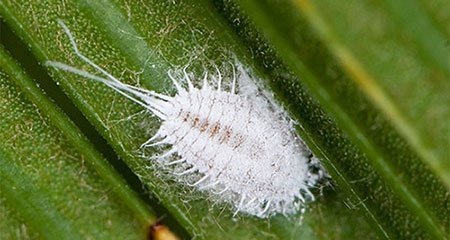

Mealybug colonies look like cotton wool
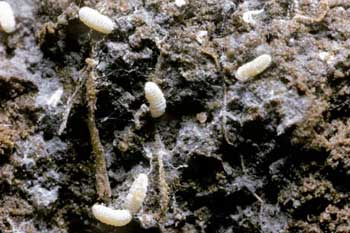

Root bug is one of the causes of root decay
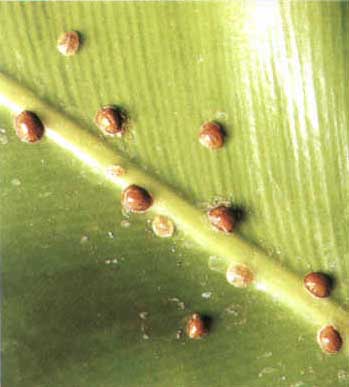

The attack of scale insects inhibits the development of the plant
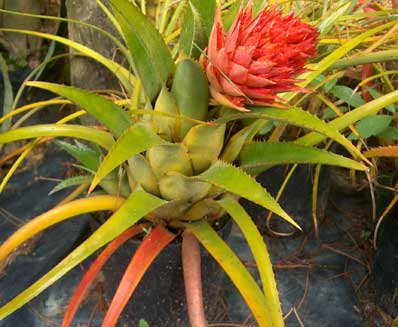

Yellow echmea leaves - a sign of root rot
How to cure root rot?
Root rot most often affects ehmeya. Let's figure out how to deal with such a nuisance.
It is necessary to remove the echmea from the pot and closely examine the state of the root system.
Important! If the entire root system is dark and soft, nothing can be done. It is necessary to get rid of the bush.
If all or most of the root system is white and firm, a simple cure should be used. For a couple of days, the ehmeya is removed from the pot. The dark parts of the roots are cut off. It is also necessary to remove the stems and foliage with manifestations of decay processes. Then you need to return the plant to the pot and water it with the carbendazim solution.
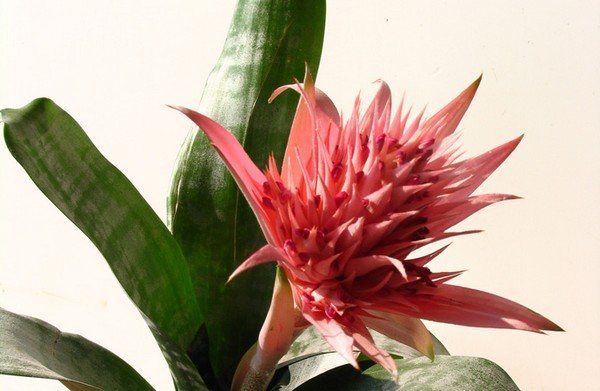

If the entire root system is affected, unfortunately, the plant cannot be saved.
If most of the root system has been damaged, you can use a surgical method to treat the disease. This method does not give one hundred percent guarantee of saving the bush, but you can try, since the chances are great. The main thing is to follow the tips outlined below.
- remove soil from the roots by holding them under running tap water;
- put ehmeya on the table and cut dark soft roots with a sharp knife;
- cut off all stems and foliage with manifestations of the decay process, the tops of the stems (this is necessary to make up for the loss of roots);
- carefully place the plant in a new pot, fresh potting soil. In the future, you need to constantly water with a solution of carbendazim;
- put the pot in a bright place, but so that the direct rays of the sun do not affect the plant;
- it is impossible to water until a new growth appears, after which such manipulations are carried out carefully so that the earth is not too wet.


You can try to save the plant by cutting off the affected roots with a knife.
Ehmeya is a rather pleasant plant that even a novice gardener can cope with, since it is not too whimsical to the surrounding conditions and does not require tremendous effort to take care of. There are not so many diseases and pests that infect it, and at most you can get rid of them without problems. So if you are considering whether to buy this plant for your home or not, be sure to purchase it!
Reviews about the cultivation of ehmea
To get a flower, a 3-year-old plant must be put in a bag along with a pot, put a few apples, tangerines or lemons there. Tie the bag and leave for 2-3 weeks. Take a spacious package, otherwise one flower just suffocated. And water the plant less, the leaves can rot!
Fillona
Ehmeya has been on my desktop for two months now and does not cease to delight me. Everyone who comes to me rushes to see “what kind of miracle is this?” Because you rarely see such beauty, I personally have not met before. The flower is unpretentious in care, my ehmeya loves the sun very much, it is directly felt how its leaves are filled with energy. The main thing is not to pour it, it is enough to water it a little once every few days. A flower for the lazy, so to speak.
Insolence
Ehmeya blooms once in a lifetime - this means that one trunk once in a lifetime, after flowering, gives children, which also bloom once in a lifetime. I have ekhmeya, probably 10 years old, bought it with a flower, the next year it bloomed, and another year, and then everything, it didn’t bloom anymore, unfortunately, I gave children regularly.
Natalya-ryzh
Varieties of plants with a description
Ehmeya Weilbach
The foliage is linear-xiphoid, soft, leathery, forming a rosette. The length of the leaves is about 50 centimeters, there is a sharpening to the top. There are also small thorns on the leaves. The foliage is green with a touch of red. The peduncle is straight, looks up, reaches a length of about half a meter. It contains a large number of crimson leaves and small size. The inflorescence is complex, in the form of a brush. The color of the bracts is juicy red.
Interesting! The petals of the plant are lilac-blue, have a snow-white edge. There are also sepals accreted by a third.
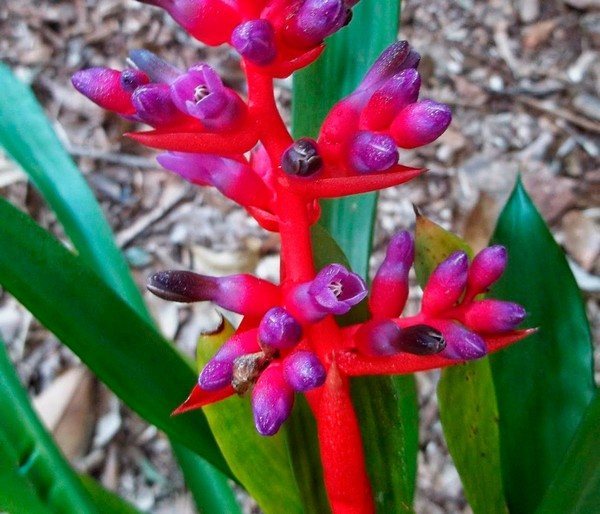

Ehmeya Weilbach has lilac-blue petals
Ehmeya two-row
This species is presented both in the form of epiphytes and in the form of terrestrial representatives. The rosette is not too dense, spreading, reaching half a meter in diameter. The leaves are long and narrow, sharp towards the top, painted green. The width is about 3 centimeters, the length is close to 50. On the edge there are dark brown thorns, located quite tightly relative to each other. The peduncle can be up to 60 centimeters or more. The flowers are lilac, the bracts are juicy red.
Interesting! There is a subspecies of this plant, in which the foliage is covered with stripes of white.
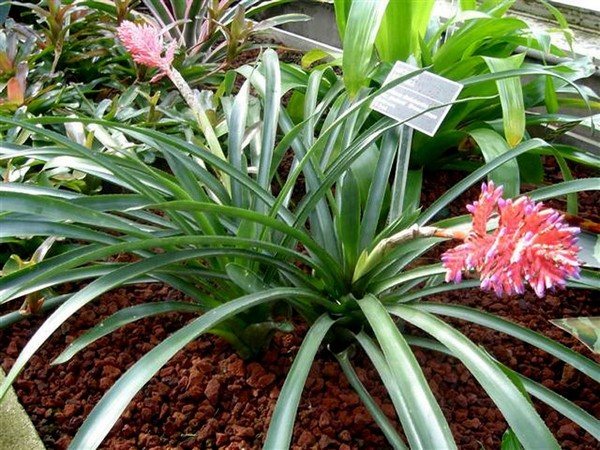

Ehmeya two-row has bright red bracts
Ehmeya curved
The variety can be an epiphyte or a terrestrial plant. The foliage is linear, framed in a socket. An individual can have from 6 to 12 rosettes. The leaves are about 50 centimeters long and one and a half centimeters wide. At the bottom, they form a tube. There are spikes on the edge, the length of which is about two millimeters. The capitate inflorescence reaches a height of 20 centimeters. The length of the petals of red flowers is about 2.5 centimeters, the bracts have a similar shade. Produces flowers in spring.
There is a variety of this culture, whose leaf rosette reaches 15 centimeters. Leaves are leathery, angled upwards. The width is approximately one and a half centimeters, the length reaches 30 centimeters. There are small spikes on the edge.
Interesting! The color of the bracts is reddish. The flowers themselves are pink.
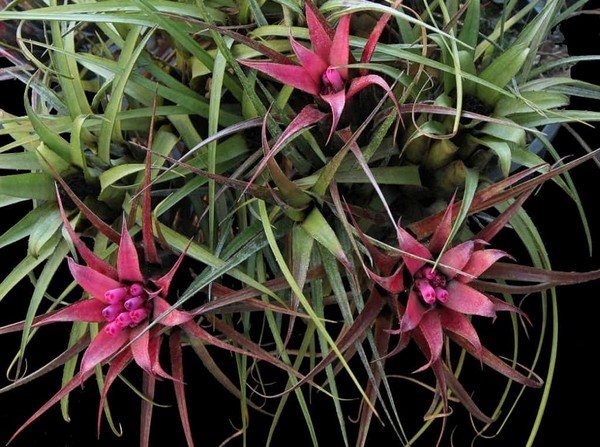

Ehmeya curved features linear foliage
Ehmeya shaggy
This plant has belt-like leaves, reaching a width of up to 5 centimeters. Length approx. 50 centimeters. The foliage forms a rosette. The apex of the culture is spinous, rounded, with small denticles on the edge. The inflorescence is an ear. Bracts are colored reddish. The flowers are juicy green.
Interesting! Such ehmeya blooms in winter.
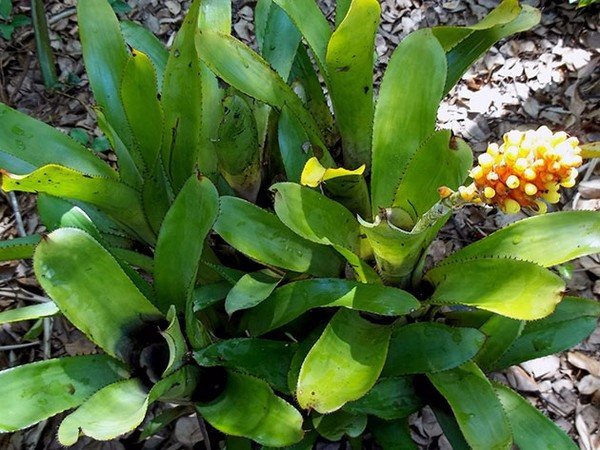

Ehmeya shaggy has belt-like leaves
Ehmeya matte red
The rosette is funnel-shaped, composed of several leaves, the width of which reaches a couple of centimeters, and the length is a maximum of 50 centimeters. The foliage is greenish, narrowed towards the base, and in this part it is painted purple. The apex is pointed. The deciduous edge has tiny teeth, and there are several scales on the surface. The peduncle is red and straight, looking up. The shape of the apical inflorescence is a pyramid. Sepals are reddish, flowers are blue. Fruits are small in size, colored pink.
Interesting! Flowering lasts quite a long time.
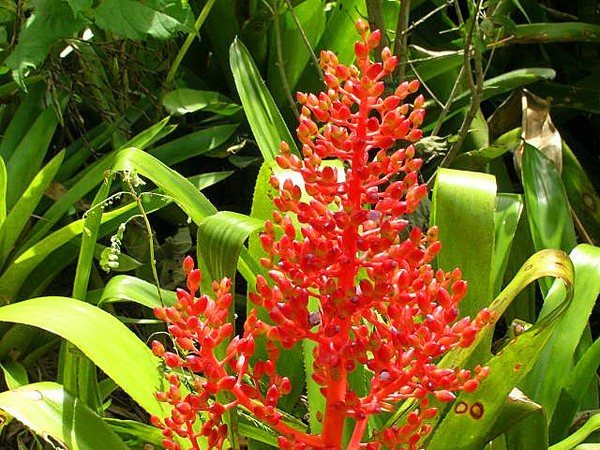

Ehmeya matte red has small blue flowers
Ehmeya striped
A leaf rosette is a tube, up to a meter in diameter. The leaves have a green-gray tint and can be up to 60 centimeters long and 6 centimeters wide. The surface is covered with transverse stripes that are marbled white. The peduncle looks up, there are scales. The inflorescence is complex, pyramidal-capitate, reaching 30 centimeters. There are inflower leaves of a pink hue. The flowers are initially blue, but then an admixture of red is added to this color.
Interesting! Sepals are covered with downs.
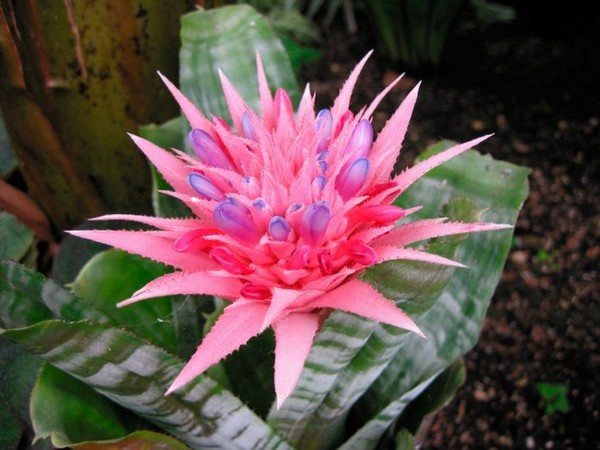

Ehmeya striped has an unusual inflorescence
Ehmeya sparkling
Leaves are belt-shaped, decorated with a rosette. The shade of the foliage is green. The width of the leaves is 6 centimeters, the length is about half a meter. The leaves are rounded to the top, teeth are located along the edges. The flowers are colored coral with red, the bracts are pink. In the process of flowering, there are up to hundreds of flowers per inflorescence.
Interesting! Experts have developed a variety of sparkling echmea - discolor: the color of the underside of the leaves is red with lilac, and its main part is olive and green.
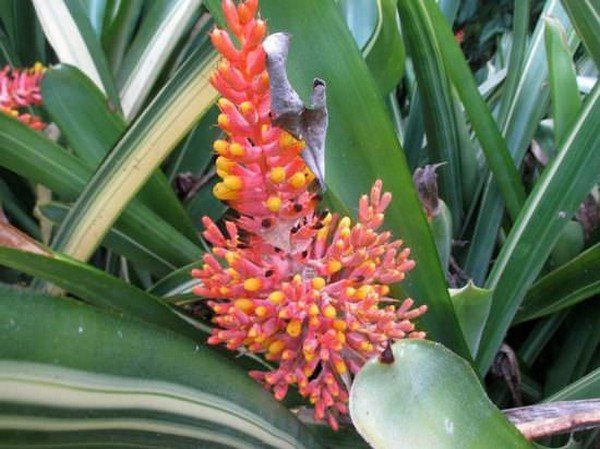

Ehmeya sparkling
Ehmeya tailed
The foliage has a deep green color, is framed in a rosette, looks up and has a strip of creamy yellow, located at the edge. The peduncle is long, forms a panicle inflorescence, collected from flowers of a golden hue.
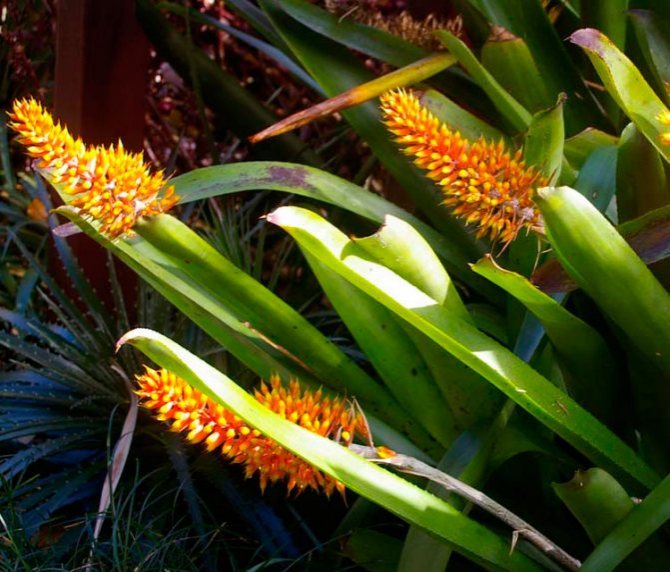

Ehmeya tailed is distinguished by beautiful golden flowers
Flower transplant
It is advisable to replant the plant in early spring. The pot can be left the same or you can choose 1-2 cm larger. In ehmea, the root system develops more in width than in depth, so it does not need a voluminous, deep pot
The only important condition is the presence of a drainage hole at the bottom.
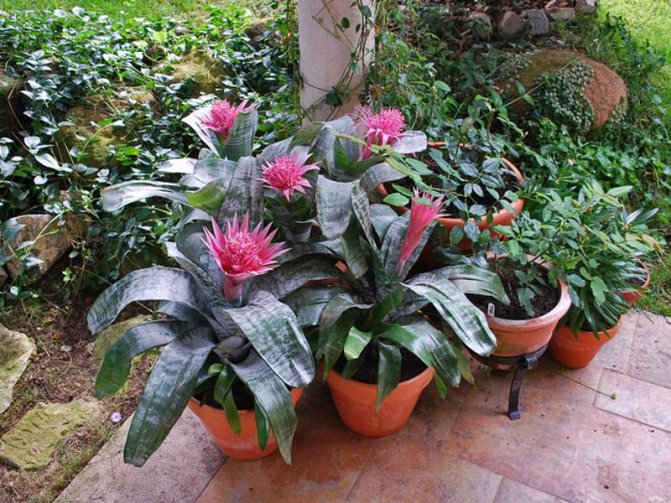

For planting a flower, you can purchase a special soil for bromeliads.Typically, it consists of peat, leafy earth and sand. To make the substrate looser, you can add pieces of bark, sphagnum moss and charcoal to it.
Before transplanting ehmeya into a new pot, carefully examine the root system, assess its condition. In general, transplantation of echmea does not present any particular difficulties, therefore, if necessary, the procedure can be carried out annually.
Remember that some types of echmea are poisonous, their juice can cause irritation on contact with the skin, so be sure to wear gloves when handling the plant.
Curved
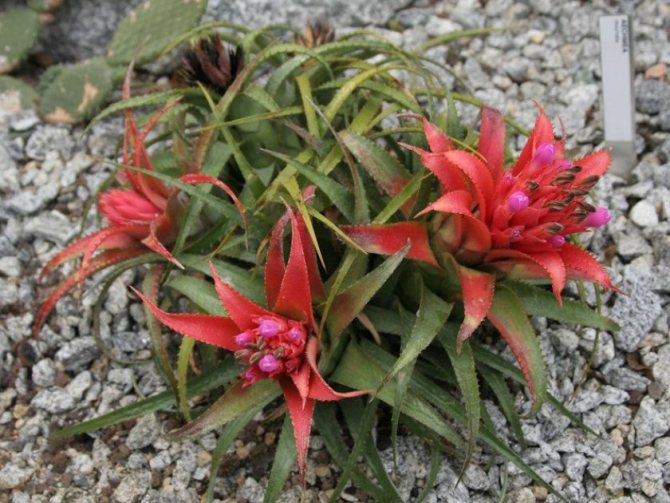

Ehmea Curved (Aechmea Recurvata)
In the wild, it occurs both as an epiphyte and as a terrestrial plant. Grows on large trees or among rocks in the rainforests of Brazil, Uruguay. The difference from other species consists in very narrow (up to 1.5 cm), long (up to 40 cm) leaves and low (up to 15-20 cm) peduncles. Leaves of gray-green color are densely covered with sharp thorns. They grow together at the base into a wide funnel. A strong peduncle is crowned with a red capitate inflorescence, consisting of elegant triangular salmon-red bracts and mauve flowers. This type of echmea blooms in the spring.
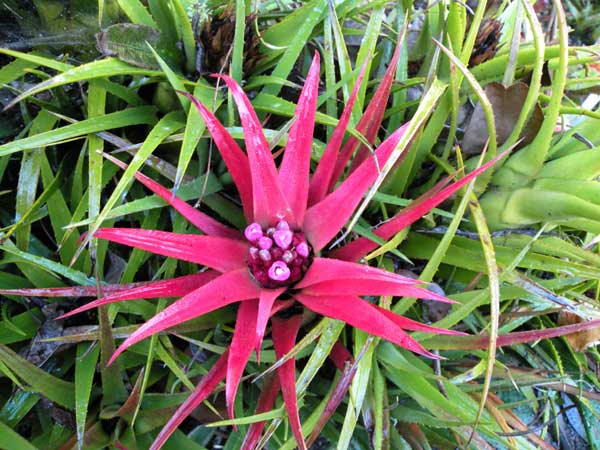

Ehmeya Curved has a varietal variety Orthosis (Ortgiesii) with thin narrow leaves of variegated color and a squat rosette.
High humidity and insufficient lighting lead to the fact that the leaves of the "Curved" echmea change their variegated color to the usual green color.
Possible difficulties
Home ficus - photo, care, reproduction, transplant, pruning
Room ehmeya - a problem-free lady, condescendingly forgiving some violations of agricultural technology
If your pet is still sick, pay attention to its appearance, determine and eliminate the cause of the ailment:
- Brown leaves of echmea, as a rule, indicate a low temperature of the content, which means that the thermophilic tropicana should be moved to a warm room. Sometimes the leaf plates of the plant turn brown due to flooding and decay of the root system. In this case, the echmea should be immediately removed from the sour soil and transplanted, having previously cut out the affected areas of the roots.
- Light dots, strokes and stripes on echmea leaves are sure signs of a pest attack. Most often, the exotic Tropicana is overcome by scale insects, ticks and root worms. Against aerial parasites, the plant is sprayed with "Agravertin" or "Fufanon", and soil pests are destroyed with a solution of "Fundazol".
- Ehmeya refuses to bloom? Low light is the cause of this fairly common problem. Lack of light can also cause leaf loss.
Sometimes it happens that ehmeya does not bloom even if all the rules of care are followed. Well, in this case, experienced florists have a little trick: loosely tie the flower pot in a plastic bag along with 2-3 ripe apples, and after 3-4 months the sloth will throw out the peduncle. The ethylene gas produced by the fruit will help to awaken the plant. The same effect can be achieved with ripening tomatoes and citrus fruits.
What is the difference between this plant
Although the flower was "born" in South and Central America, in our climate it also took root well. Moreover - here he is considered very unpretentious. That is why many flower growers love ehmeya so much.
This is what a plant looks like "in the wild":
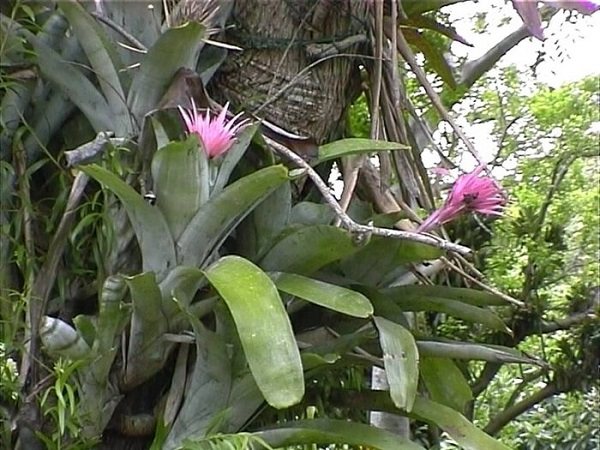

The only "but": even if you find tiny echmeas in small pots in the store, it is worth remembering that they will grow quickly and for them you will have to allocate not a window sill, but a full-fledged corner in the hall. Therefore, ehmei are primarily bred by owners of large apartments, country houses, and also winter gardens.
The plant is also interesting for its flower. Its shape and shade differ in appearance. What unites all ehmei is that the bush blooms only once in a lifetime. After the flower withers, the bush will grow "babies".They can grow for a long time in the same “apartment” with the “mother”, but then (during transplantation) they will need to be separated and transplanted into separate pots.
The most popular types of room ehmea
In nature, there are about 170 species of this plant (although some botanists increase this figure to 300). People cultivate at times less. I will name the most popular of those that can be bought in domestic stores.
Sparkling (shiny). Blooms with coral flowers. You can rarely see it here, as the species is very finicky and difficult to grow. Although real fans grow not only "basic" varieties, but also variegated varieties (with colored leaves, as in the photo above).
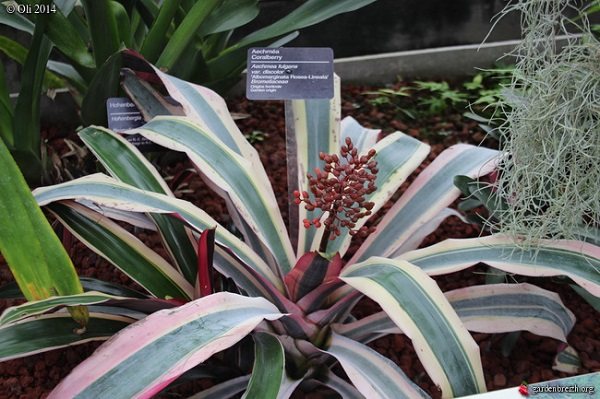

Curved. It has narrow leaves pointed at the ends. They form the same rosette as in other types of echmea. The leaf plate is smooth, but there are a number of spines along the edges.
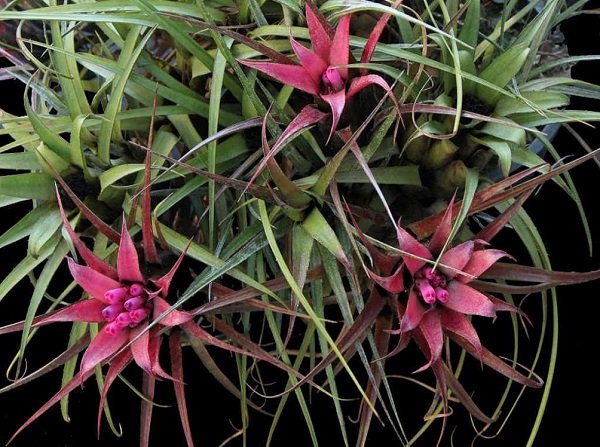

Striped. This is probably the most popular type of ehmea in our country. Has wide green leaves, unevenly covered with a white "bloom". The flower is very beautiful, deep pink, similar in shape to a lotus flower.
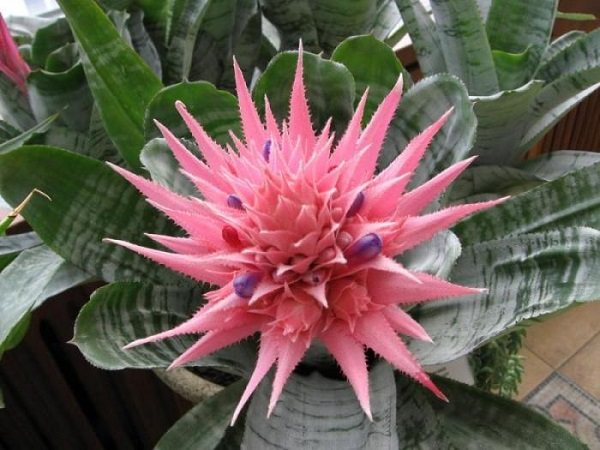

Bearded (tailed). It blooms with a reddish "panicle".
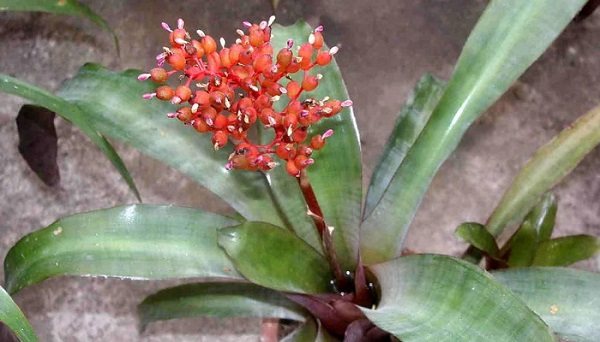

Lindena (shaggy). It has bright green broad leaves, protected along the edges by sharp dark thorns. It blooms in winter, the species has a large, spike-shaped inflorescence, yellow flowers bloom on the red bracts. The bush grows up to a meter in height.
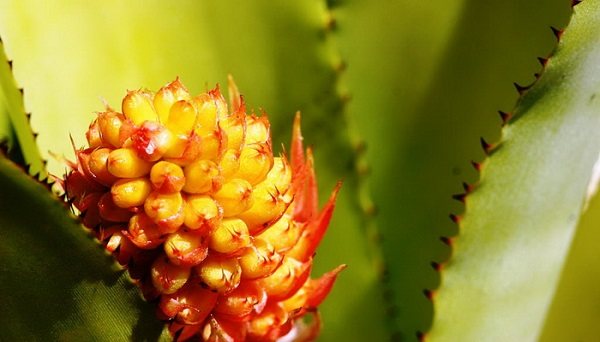

Weilbach. The species looks like a striped echmea, but the flowers are of a more delicate shade (although someone would call them "faded"). The green leaves at the base are burgundy.
